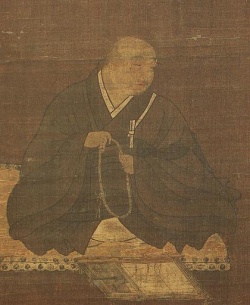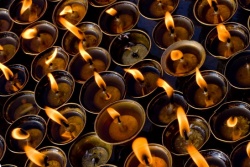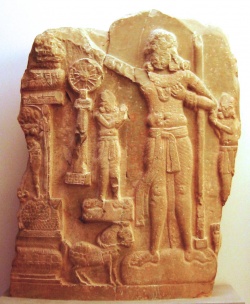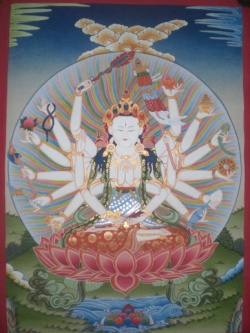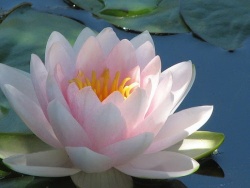Honen
Honen
法然 (1133–1212)
Also known as Genku. The founder of the Pure Land (Jodo) school in Japan. Born in Mimasaka Province, in 1141 Honen became a disciple of his uncle, Kankaku, a priest of the Tendai school in the province, in accord with the wishes of his assassinated father.
In 1145 (1147 according to another account) he entered Enryaku-ji temple on Mount Hiei, where he studied the teachings of the Tendai school under Genkoand Koen.
In 1150 he began to study the Pure Land teachings under Eiku.
He left Kurodani on Mount Hiei, where Eiku lived, and went to study the doctrines of other schools. On his return he read through the Buddhist canon.
He is said to have reached an awakening in 1175 upon reading The Commentary on the Meditation on the Buddha Infinite Life Sutra by Shan-tao, a patriarch of the Chinese Pure Land school.
Thereafter he dedicated himself solely to the Pure Land practice of Nembutsu, or the chanting of Amida Buddha's name.
The Pure Land school in Japan considers this awakening by Honen as the date of its founding. Honen then moved to Yoshimizu in Kyoto where he devoted himself to the exclusive practice of Nembutsu and attracted a great number of followers.
In 1186, at the request of Kenshin, later the chief priest of Enryaku-ji on Mount Hiei, Honen preached the Pure Land teachings at Shorin-in temple in Ohara, Kyoto, where he is said to have refuted priests of the Dharma Characteristics (Hosso), Three Treatises (Sanron), Flower Garland (Kegon), and other schools.
This event is known as the Ohara Discourse. Alarmed at the spread of his teachings, the priests of Mount Hiei and Kofuku-ji temple, a major temple in Nara, petitioned the throne against Honen.
Matters came to a head in 1206, when two court ladies were persuaded to become nuns of the Pure Land school at a prayer service conducted by Honen's disciples Junsai and Juren.
This incident aroused the anger of the Retired Emperor Gotoba, who banned the Pure Land teaching and exiled Honen to Tosa in 1207.
In 1211 he was permitted to return to the capital, where he died the following year. Honen's best-known work is The Nembutsu Chosen above All, written in 1198.
In it, he defines the cause for attaining rebirth in the Pure Land to be the exclusive practice of Nembutsu, and urges that people discard all sutras other than the three basic sutras of the Pure Land teaching (the Buddha Infinite Life Sutra, the Meditation on the Buddha Infinite Life Sutra, and the Amida Sutra).
He also wrote commentaries on the three Pure Land sutras and on The Essentials of Rebirth in the Pure Land by Genshin.
Hōnen (法然?, May 13, 1133 – February 29, 1212) is the religious reformer and founder of the first independent branch of Japanese Pure Land Buddhism called Jōdo-shū (浄土宗?, "The Pure Land School").
In the related Jōdo Shinshū sect, he is considered the Seventh Patriarch. Hōnen became a monk of the Tendai sect at an early age, but grew disaffected, and sought an approach to Buddhism that anyone could follow, even during the perceived Age of Dharma Decline.
After discovering the writings of Chinese Buddhist, Shan-tao, he undertook the teaching of rebirth in the Pure Land of Amitabha through reciting the Buddha's name, or nembutsu.
Hōnen gathered a wide array of followers, but also critics.
The emperor exiled Hōnen and his followers in 1207, after an incident regarding two of his disciples, in addition to persuasion by certain influential Buddhist communities.
Hōnen was eventually pardoned and allowed to return to Kyoto where he stayed for a short time before his death.
Biography
Early life
Hōnen was born to a prominent family in city of Kume, in Mimasaka province.
His father was Uruma no Tokikuni, a province official who headed up policing in the area. His mother was of the Hada clan, whose ancestry could be traced back to the silk merchants of China. Hōnen was originally named Seishi-maru after the bodhisattva Seishi (Mahāsthāmaprāpta in Sanskrit).
In 1141 Hōnen's father was assassinated by Sada-akira, an official sent by Emperor Horikawa to govern the province.
It is believed that Tokikuni's last words to his son were, "Don't hate the enemy but become a monk and pray for me and for your deliverance."
Fulfilling his father's wishes for him, Hōnen was initiated into his uncle's monastery at the age of nine. From then on, Hōnen lived his life as a monk, and eventually studied at the primary Tendai temple at Mount Hiei, located near Kyoto.
Clerics at Mt. Hiei took the bosatsukai (vows of the Bodhisattva) and then undertook 12 years of training at Mt. Hiei; a system developed by the Tendai sect's founder, Saichō.
While at Mt. Hiei, he studied under Genkō (源光), Kōen (皇円) and later, with Eikū (叡空). Under Kōen he was officially ordained as a Tendai priest, while under Eikū he received the name Hōnen-bō Genkū (法然房源空).
In speaking of himself, Hōnen often referred to himself as Genkū, as did his close disciples.
Departure from Mt. Hiei
While studying on Mt. Hiei, Hōnen devoted his time to finding a way to bring salvation to all beings through Buddhism, but was not satisfied with what he found at Mt. Hiei.
At the age of 24, Hōnen then went to study at the city of Saga, then Nara, and stayed at such temples at Kōfuku-ji and Tōdai-ji. Still not satisfied, he returned to the libraries of Mt. Hiei and studied further.
During this period, Hōnen read a Pure Land Buddhist text called the Commentaries on the Contemplation Sutra (Chinese: 觀經四帖疏; pinyin: Guān jīng sì tiè shū), authored by Chinese Pure Land master Shan-tao, notably the statement:
“ "Only repeat the name of Amitabha with all your heart.
Whether walking or standing, sitting or lying, never cease the practice of it even for a moment. This is the very work which unfailingly issues in salvation, for it is in accordance with the Original Vow of that Buddha." ”
This commentary persuaded Hōnen to believe that nembutsu was all one needed to enter Amida Buddha's Pure Land.
Previously, the nembutsu was recited along with other practices, but Shan-tao was the first to propose that only the nembutsu was necessary.
This new appreciation and understanding Hōnen held for nembutsu prompted him to leave Mt. Hiei and the Tendai tradition in 1175.
Beginnings of a New Sect
Hōnen relocated to the district of Ōtani in Kyoto where he started addressing crowds of men and women, establishing a considerable following.
Hōnen attracted fortune-tellers, ex-robbers, samurai and other elements of society normally excluded from Buddhist practice.
Hōnen was a man of recognition in Kyoto, and many priests and nobleman allied with him, and visited him for spiritual advice. Among them was an imperial regent named Kujō Kanezane (1149–1207).
The increasing popularity of his teachings drew criticism from noted contemporaries as Myōe and Jōkei among others, who argued against Hōnen's sole reliance on the nembutsu as a means of rebirth in the Pure Land.
Additionally, some disciples interpreted Hōnen's teachings in unexpected ways, leading to disreputable behavior, criticism of other sects, or other forms of antinomianism.
In 1204, the monks at Mt. Hiei implored the head priest to ban the teachings of exclusive nembutsu and to banish any adherents from their principality.
In 1205 the temple of Kōfuku-ji, located in Nara, implored the Emperor Go-Toba to sanction Hōnen and his followers. The temple provided the emperor with nine charges alleging unappeasable differences with the so-called eight schools.
Hōnen's detractors cited examples of Hōnen's followers, such as Gyoku and Kōsai who committed vandalism against Buddhist temples, intentionally broke the Buddhist precepts, or caused others to intentionally turn away from established Buddhist teachings. Richard Bowring condenses these charges into two general forms.
First is the nature of a single practice. Hōnen's emphasis on the single practice of nembutsu denied the usefulness of all other Buddhist practices, which irked other sects. The sole emphasis on Amida Buddha was also coupled with discouraging the traditional worship of the kami.
The second charge was that Hōnen placed the most lowly lay-person on equal footing with the wisest monk, rendering the entire monastic establishment as useless,a gain raising the ire of other sects.
In response, Hōnen censured Kōsai's single-nembutsu teaching, and his followers agreed to sign the Shichikajō-kishōmon (七箇条起請文?, "Seven Article Pledge"), which called for restraint in moral conduct and in interactions with other Buddhist sects.
The clamour surrounding Hōnen's teachings dissipated for a time until 1207 when Go-Toba implemented a ban against exclusive nembutsu, stemming from an incident where two of Hōnen's most prominent followers were accused of using nembutsu practice as a coverup for sexual liaisons.
As part of the ban, Hōnen and some of his disciples (including Shinran) were exiled, while the priests responsible for the conversion, Juren and Anrakubo, were executed. Hōnen is said to have responded:
“ I have labored here in the capital these many years for the spread of the Nembutsu, and so I have long wished to get away into the country to preach to those on field and plain, but the time never came for the fulfillment of my wish. Now, however, by the august favor of His Majesty, circumstances have combined to enable me to do so."
”
Exile and the Final Years
Hōnen was exiled to Tosa, but the movement in Kyoto had not thoroughly gone away. While in exile, Hōnen spread the teachings to the people he met - fishermen, prostitutes, and the peasantry.
In 1211 the nembutsu ban was ultimately lifted, and Hōnen was premitted to return to Kyoto.
In 1212, the following year, Hōnen died in Kyoto, but was able to compose the One-Sheet Document (一枚起請文 Ichimai-kishōmon?) a few days before he died.
Character
Analysis of various historical documents by the Jodo Shu Research Institute suggests several obvious characteristics of Hōnen's personality:
a strict master
introspective and self-critical
a bold innovator
a critic of scholasticism
a man more concerned with solving the problems of daily life rather than worrying about doctrinal matters
On the latter point Hōnen expressed unusual concern over the spiritual welfare of women. In teaching to them, regardless of social status (from aristocracy to prostitutes),
he particularly rejected the significance of menstruation; which wider Japanese religious culture considered to cause spiritual defilement.
As a consequence the role of women in the Jōdo-shū sects has often been greater than in some other Japanese Buddhist traditions.
About himself Hōnen reportedly said:
“ [I lack] the wisdom to teach others. Ku Amida Butsu of Hosshō-ji, though less intelligent, contributes in leading the people to the Pure Land as an advocate of the nembutsu.
After death, if I could be born in the world of humans, I would like to be born a very ignorant man and to diligently practice the nembutsu. (Tsuneni Oserarekeru Okotoba - Common Sayings of Hōnen) ”
Doctrine
Writings
Hōnen's main document expounding his Pure Land doctrine is the Senchaku Hongan Nenbutsushū written in 1198 at the request of his patron Lord Kujō Kanezane (1148–1207).
The document was not widely distributed by Hōnen's request until after his death.
The only other document from Hōnen is his last testament, the Ichimai-kishōmon (一枚起請文) or "One-Sheet Document".
Most of Hōnen's teachings are recorded by his disciples, or recorded later by Buddhist historians in the 14th century.
Quotation
Hōnen's teachings are briefly summarized in his final work, the One-Sheet Document:
"In China and Japan, many Buddhist masters and scholars understand that the nembutsu is to meditate deeply on Amida Buddha and the Pure Land.
However, I do not understand the nembutsu in this way. Reciting the nembutsu does not come from studying and understanding its meaning.
There is no other reason or cause by which we can utterly believe in attaining birth in the Pure Land than the nembutsu itself.
Reciting the nembutsu and believing in birth in the Pure Land naturally gives rise to the three minds (sanjin) and the four modes of practice (shishu).
If I am withholding any deeper knowledge beyond simple recitation of the nembutsu, then may I lose sight of the compassion of Shakyamuni and Amida Buddha and slip through the embrace of Amida's original vow.
Even if those who believe in the nembutsu deeply study all the teachings which Shakyamuni taught during his life, they should not put on any airs and should practice the nembutsu with the sincerity of those untrained followers ignorant of Buddhist doctrines.
I hereby authorize this document with my hand print. The Jōdo Shū way of the settled mind (anjin) is completely imparted here. I, Genkū, have no other teaching than this.
In order to prevent misinterpretation after my passing away, I make this final testament."
Hōnen's practical advice on practicing the nembutsu can be summed up in these two statements:
"If, because it is taught that birth is attained with but one or ten utterances, you say the Nembutsu heedlessly, then faith is hindering practice.
If, because it is taught that you should say the Name without abandoning it from moment to moment, you believe one or ten utterances to be indecisive, then practice is hindering faith.
As your faith, accept that birth is attained with a single utterance; as your practice, endeavor in the Nembutsu throughout life."
"Only repeat the name of Amida with all your heart. Whether walking or standing, sitting or lying, never cease the practice of it even for a moment. This is the very work which unfailingly issues in salvation..." (Hōnen quoting Shan-tao)
